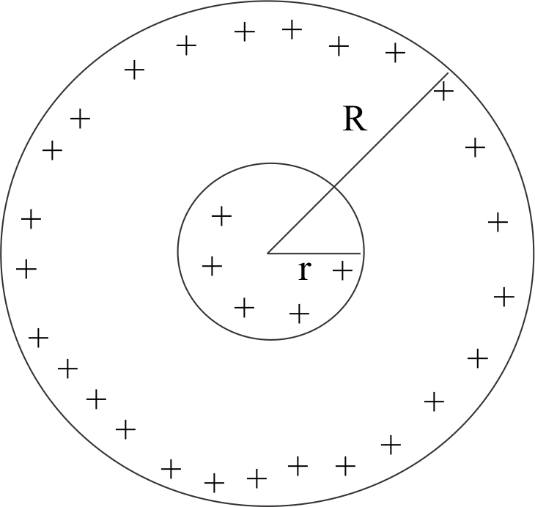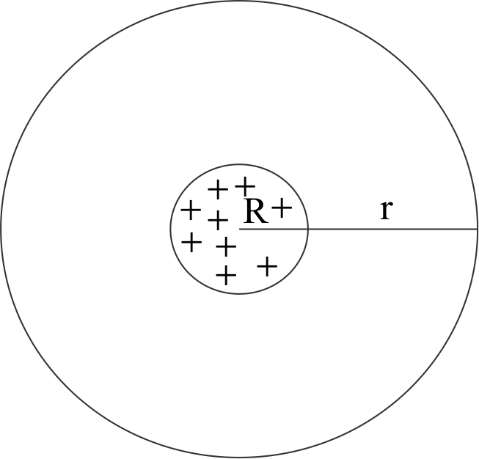
Electric field due to uniformly charged sphere.
Answer
216k+ views
Hint: This is the case of solid non-conducting spheres. We will have three cases associated with it . They are : electric fields inside the sphere, on the surface, outside the sphere .
Apply the gauss theorem to find the electric field at the three different places.
Complete step by step solution:
Consider a charged solid sphere of radius $R$ and charge $q$ which is uniformly distributed over the sphere. We will use Gauss Theorem to calculate electric fields. If $\phi $ be the electric flux and $Q$ be the charge then :
${\varepsilon _0}\phi = {Q_{enclosed}}$
Also , electric flux=electric field X area of the enclosed surface : $\phi = EA$
Case I- Inside the sphere $(r < R)$

The charge distribution is uniform . Volume density will be the same. Let the charge enclosed by a circle of radius $r$ be $q'$ . Since volume density is same then-
$
\dfrac{{q'}}{{\dfrac{4}{3}\pi {r^3}}} = \dfrac{q}{{\dfrac{4}{3}\pi {R^3}}} \\
q' = q\dfrac{{{r^3}}}{{{R^3}}} \\
$
Applying Gauss Theorem here-
$
\phi = E4\pi {r^2} \\
\dfrac{{{Q_{enclosed}}}}{{{\varepsilon _0}}} = E4\pi {r^2} \\
\dfrac{{q'}}{{{\varepsilon _0}}} = E4\pi {r^2} \\
\dfrac{q}{{{\varepsilon _0}}} \times \dfrac{{{r^3}}}{{{R^3}}} = E4\pi {r^2} \\
E = \dfrac{1}{{4\pi {\varepsilon _0}}} \times \dfrac{{qr}}{{{R^3}}} \\
$
This is the electric field inside the charged sphere .
Case II: On the surface $(r = R)$
In the above case we have calculated the electric field inside the sphere. In that formula we will put $(r = R)$ , so evaluate the electric field on the surface of the sphere .
$
E = \dfrac{1}{{4\pi {\varepsilon _0}}} \times \dfrac{{qr}}{{{R^3}}} \\
E = \dfrac{1}{{4\pi {\varepsilon _0}}} \times \dfrac{{qR}}{{{R^3}}} \\
E = \dfrac{1}{{4\pi {\varepsilon _0}}} \times \dfrac{q}{{{R^2}}} \\
$
This is the electric field on the surface.
Case III: Outside the sphere $(r > R)$

We will apply Gauss theorem in this too.
$
\phi = EA \\
\dfrac{q}{{{\varepsilon _0}}} = E4\pi {r^2} \\
E = \dfrac{1}{{4\pi {\varepsilon _0}}} \times \dfrac{q}{{{r^2}}} \\
$
This is the electric field outside the sphere.
If we plot these variations on a graph we will get the following graph:

Note: Since this is a solid sphere , it has charge inside it as well and that is why the electric field is non zero. In case of a hollow spherical shell, the electric field inside the shell is zero .
Apply the gauss theorem to find the electric field at the three different places.
Complete step by step solution:
Consider a charged solid sphere of radius $R$ and charge $q$ which is uniformly distributed over the sphere. We will use Gauss Theorem to calculate electric fields. If $\phi $ be the electric flux and $Q$ be the charge then :
${\varepsilon _0}\phi = {Q_{enclosed}}$
Also , electric flux=electric field X area of the enclosed surface : $\phi = EA$
Case I- Inside the sphere $(r < R)$

The charge distribution is uniform . Volume density will be the same. Let the charge enclosed by a circle of radius $r$ be $q'$ . Since volume density is same then-
$
\dfrac{{q'}}{{\dfrac{4}{3}\pi {r^3}}} = \dfrac{q}{{\dfrac{4}{3}\pi {R^3}}} \\
q' = q\dfrac{{{r^3}}}{{{R^3}}} \\
$
Applying Gauss Theorem here-
$
\phi = E4\pi {r^2} \\
\dfrac{{{Q_{enclosed}}}}{{{\varepsilon _0}}} = E4\pi {r^2} \\
\dfrac{{q'}}{{{\varepsilon _0}}} = E4\pi {r^2} \\
\dfrac{q}{{{\varepsilon _0}}} \times \dfrac{{{r^3}}}{{{R^3}}} = E4\pi {r^2} \\
E = \dfrac{1}{{4\pi {\varepsilon _0}}} \times \dfrac{{qr}}{{{R^3}}} \\
$
This is the electric field inside the charged sphere .
Case II: On the surface $(r = R)$
In the above case we have calculated the electric field inside the sphere. In that formula we will put $(r = R)$ , so evaluate the electric field on the surface of the sphere .
$
E = \dfrac{1}{{4\pi {\varepsilon _0}}} \times \dfrac{{qr}}{{{R^3}}} \\
E = \dfrac{1}{{4\pi {\varepsilon _0}}} \times \dfrac{{qR}}{{{R^3}}} \\
E = \dfrac{1}{{4\pi {\varepsilon _0}}} \times \dfrac{q}{{{R^2}}} \\
$
This is the electric field on the surface.
Case III: Outside the sphere $(r > R)$

We will apply Gauss theorem in this too.
$
\phi = EA \\
\dfrac{q}{{{\varepsilon _0}}} = E4\pi {r^2} \\
E = \dfrac{1}{{4\pi {\varepsilon _0}}} \times \dfrac{q}{{{r^2}}} \\
$
This is the electric field outside the sphere.
If we plot these variations on a graph we will get the following graph:

Note: Since this is a solid sphere , it has charge inside it as well and that is why the electric field is non zero. In case of a hollow spherical shell, the electric field inside the shell is zero .
Recently Updated Pages
Circuit Switching vs Packet Switching: Key Differences Explained

Mass vs Weight: Key Differences Explained for Students

Alpha, Beta, and Gamma Decay Explained

Alpha Particle Scattering and Rutherford Model Explained

Angular Momentum of a Rotating Body: Definition & Formula

Apparent Frequency Explained: Formula, Uses & Examples

Trending doubts
JEE Main 2026: Application Form Open, Exam Dates, Syllabus, Eligibility & Question Papers

JEE Main Correction Window 2026 Session 1 Dates Announced - Edit Form Details, Dates and Link

Derivation of Equation of Trajectory Explained for Students

Hybridisation in Chemistry – Concept, Types & Applications

Understanding the Angle of Deviation in a Prism

Understanding Collisions: Types and Examples for Students

Other Pages
JEE Advanced Marks vs Ranks 2025: Understanding Category-wise Qualifying Marks and Previous Year Cut-offs

How to Convert a Galvanometer into an Ammeter or Voltmeter

Atomic Structure: Definition, Models, and Examples

Ideal and Non-Ideal Solutions Explained for Class 12 Chemistry

Degree of Dissociation: Meaning, Formula, Calculation & Uses

Understanding Electromagnetic Waves and Their Importance




